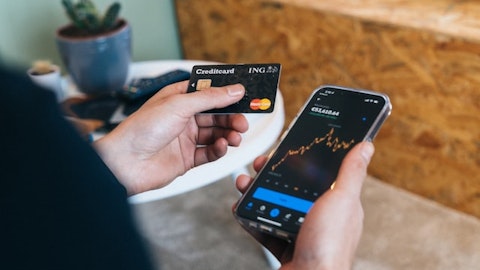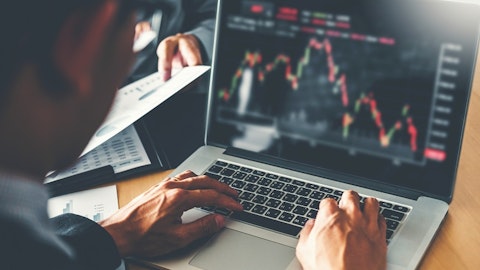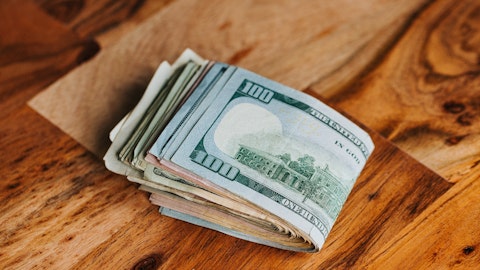But in a market like this, you don’t really mind payoffs, because I think that that’s — credit quality is a question in a market like this. And so far, we’re doing well.
Pamela McCormack: I just wanted to — when Brian says a $100 million of cash, that comfort level comes is supported by a $324 million unsecured line that we could draw at any time.
Jade Rahmani: Okay. On the IG front, investment-grade, is that still the company’s number one strategic priority or is that just aspirational? And in achieving investment-grade, what are the main, pitfalls. What would you have to give up?
Paul Miceli: Pamela, you want to take that one?
Pamela McCormack: Yes. I mean, I we are absolutely still committed to try and become an investment-grade company, we’ll always be balancing that against the cost of funds and ROE. But, for us, it has been a pretty objective. We have to get to 50% of our debt is unsecured debt versus the 41% today. So not a terrible stretch and we continue to think it will be a big differentiator for Ladder. And if you look at just the way we run the company today, we’re a slightly smaller meaner company today with a $300 million to $400 million less of assets, but all of our other all of our debt levels, our cash, liquidity is higher, lower leverage, higher percentage of non-mark-to-market debt, larger amount of unencumbered assets, we’re well-positioned to do it when the market allows at a price that’s accretive to Ladder.
And we think it’ll be a real differentiator for Ladder in the space. I think there’s a — I personally am a big fan of it and think there is, a space in the market for a high single-digit, low double-digit investment-grade company with primarily senior sure to access. We pretty much run the company that way today anyway.
Paul Miceli: Yes. And the only thing I would add, Jade, is we began the process, perhaps not an it was an aspirational goal years and years ago, but given where we are now, we’ve kind of, almost gotten there and that we’re at over, I think, over 40% of our liabilities are unsecured right now. We still maintain firmly that if there was ever proof that that having unsecured term debt is a is a winner not a loser in the say it has been proven right here. Although admittedly, we were paying higher prices than a lot of others, when LIBOR was at 12 basis points, But taking the long view as, inside our owners do, we, yeah, we feel pretty comfortable with it. We still think it’s the right strategy. But, do we think that we would not part with some of this liquidity and acquire some of those unsecured bonds that aren’t due for years given the prices that they’re at, we absolutely will do that.
We have no concerns at all about that kind of rigidness of keeping unsecured debt outstanding.
Pamela McCormack: Just one note on one for the note, Jade. We have $3 billion, more than half of our assets right now, 55% are unencumbered. It’s really meaningful and I think not just it positions the company. I think one of the big questions right now when you’re looking credit is no one wants to be a forced seller in this market. I can’t even begin to describe the flexibility we have on the balance sheet right now to be patient when we need to be.
Jade Rahmani: Thank you very much.
Operator: Thank you. Our next question is from Steve DeLaney with JMP Securities. Please proceed with your question.
Steve DeLaney: Good morning, everyone, and congrats on another strong quarter and what is obviously a very tough environment. I’m curious where you guys stand currently on required distributions of re taxable income? At some point, the next few quarters, is there a chance that you would need to pay out a special dividend? And, obviously, what I’m looking at is distributable EPS versus your dividend? And I realized that taxable is a, you know, is a is a different calculation for sure. So, if you guys could comment on that, I’d appreciate it.
Paul Miceli: Hey, Steve. This is Paul. So, 2020, no, we don’t anticipate a special dividend, but it’s something we’re monitoring carefully as get it to 2024.
Steve DeLaney: Okay. So, it sounds like you’re — it sounds like if you continue to put good earnings and you don’t do anything with it that maybe that would be an option next year. Of course, you can always just boost the regular quarterly payout.
Pamela McCormack: I was about to say Steve. I think you should just assume that the Board will regularly consider the dividend every quarter.
Steve DeLaney: Sure. And obviously just the more we said and think about it as an investor and analyst, a lot more return and utility and boosting the regular than a special. People have short memories and they forget those special dividends. So, you probably only do it when you have to do it. Just looking forward to get to a better place in 2024, you’ve talked a lot about willing to be more offensive. Brian, what are — what’s the — a lot of reasons that got us in the place we are now and unbelievable rate increases, rapid increases in rates is certainly one of those things, I think, probably the most disruptive. But looking out to next year, what would be the top one or two things in the macro financial regulatory complex. What does this market really need to kind of get back to some sense of normalcy in terms of risk return?
Brian Harris: I think if the Fed — and I think they will get to this point, I think the Fed will get to a point where they indicate they’re going to stop raising rates. That will be — they don’t have to cut rates, but they have to stop raising rates. And that’ll be a big step in the right direction. And I think a lot of asset classes will go up in value as a result of that. Right now, there’s a lot of headline asset classes that would make you think things are going okay. But this is a pretty — this is the third year of a difficult fixed income investment environment. And fixed income investors aren’t usually losing money three years in a row, but this time they are. So, if nothing else, I mean, I think the bond investor has been whipsawed around.
He’s been told to buy duration because rates will be getting cut. I’ve never really seen more economists forecasting rate cuts before the end of a rate cycle or a recession even arrives. So, there’s been a lot of information and opinions, which change rapidly. No shortage of changed opinions at the Fed. So, I think a little stability around not going to get worse would go a long way right now. And I think you kind of see this even in the real estate side where, like, for instance, I hit a point with Francisco where I said, can I possibly hear anything about San Francisco that would make me think it’s worse. And you hit a point where you just can’t. And then things you all of a sudden, you start looking at some headlines and they’re getting better, a little bit better here and there.
The AI complex out in Hayes Valley is doing pretty well. So, yes — it’s really the first thing is — as I say, when you’re when you’re digging a hole, put the shovel down, it’s I think it’s that mentality of it. Okay, the worst is over. And I don’t think we feel that way just yet. Although the worst is almost over, it’s probably comfortable. Obviously, what would really move this thing around is if you took a 100 basis points off the tenure. That that would certainly do it. Right now, I think primarily what we’re dealing with is a Fed-induced commercial real estate recession. They did it on purpose. And it isn’t just supply and demand, it’s — carrying costs are gigantic. And it’s unfortunate when you see property owners who actually executed their business plan pretty well and on time, and then they have to go buy a cap that costs millions of dollars because just two years ago, cap rates cost almost nothing.
I’ll say also though that one of the reasons we might have been just holding off a bit on the aggressiveness side is we wrote a $1 billion worth of loans in the fourth quarter of 2021. And since we write a lot of short loans, we’re now in the fourth quarter of 2023. So, we’re getting a pretty good report card and since as to okay, how did we do? Are we as good at credit as we say we are? And we feel pretty good. So, once we start to — you may see payoffs pick up here because we’re coming up to that two-year period where borrowers are going to have to re-up a cap, maybe some reserves and put more equity. So, I think that because we wrote a lot of loans after the pandemic effectively ended, the leverage is a little lower in our operation as well as the loan balances being smaller.




